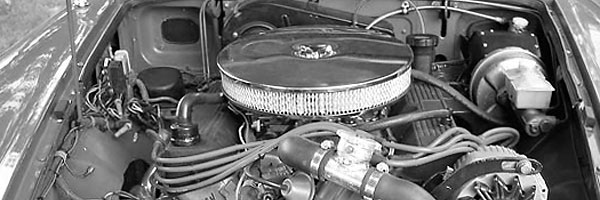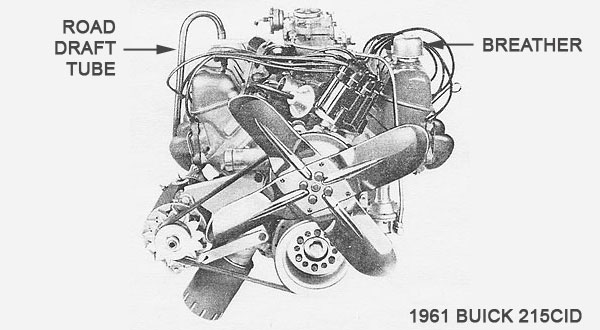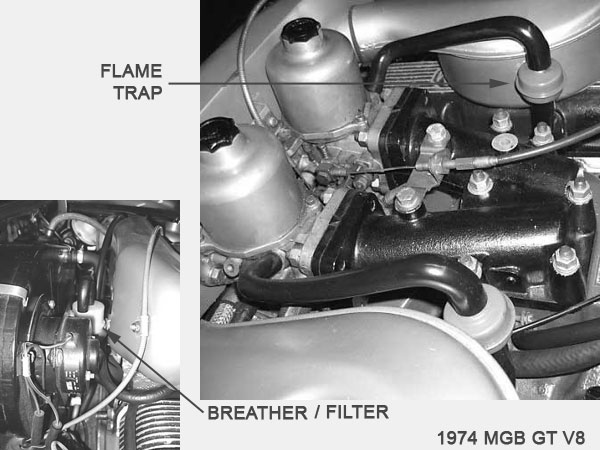
Positive Crankcase Ventilation
as published in BritishV8 Magazine, Volume XVII Issue 1, July 2009by: Jim Blackwood
The positive crankcase ventilation (PCV) system, and older "road tube" systems
that preceded PCV, are for venting combustion products from the crankcase in
the most unobtrusive manner consistent with the times. To understand these
systems, it's necessary to realize that "blowby" inevitably exists in any internal
combustion engine. For example, whenever a piston engine runs, there will be
some passage of gasses and vapors past the piston rings, and into the crankcase.
This will occur despite the finest components, the most precise machining and
the most careful assembly. Blowby includes volatile and potentially explosive
fuel fumes, as well as contaminants that degrade oil. (Solids, such as ash, are
carried with the gasses.) Modern sealing methods are simply incapable of preventing
blowby. It may not be much, but blowby is inevitable and it has to be dealt with.
Originally engines were built with an open crankcase and no special provision was
needed. The closed crankcase came about because of a desire to re-use the
lubricating oil which had previously been allowed to simply fall to the ground.
As this evolved, manufacturers began sealing the crankshaft from the outside
environment to both contain the oil and exclude contaminants. Engine speeds were
increasing as well and pressurized lubricating systems were needed to deal with
the increased bearing loads, meaning there was a great deal more oil being flung
about. At this point it became clear that venting of some sort was required to
avoid pressurizing the crankcase to a level which seals and gaskets weren't capable
of withstanding, and various types of vents were developed. Due to the possibility
of crankcase explosions almost all of these venting methods also included a flame
arrestor of some type, but they were in general as simple and direct as engine
manufacturers could make them.
The problem with this type of vent of course is that it was nearly impossible to
remove all of the oil from the vapors that exited the vent, and as a result an
oily residue was deposited nearby. Also under heavy acceleration when cylinder
pressures are highest and the most blowby is produced, enough fumes exited the
vents to create objectionable fumes in the passenger compartment of the vehicle.
These problems led to development of the road tube which was very effective,
resulted in much cleaner engine compartments and cleaner air for the driver and
passengers. It diverted the objectionable fumes and oil spray down under the car
and was a significant advance. The downside was that the oil vapors were now
deposited on the road surface, leaving a wide, dark oily swath between the two
tire tracks of public roads.

It was soon discovered that by cutting the end of the road draft tube at an angle
and extending it into the airstream below the car an actual flow of fresh air could
be created through the engine by providing an inlet breather, often in the form of
an oil filler cap with a coarse mesh filter material, which acted as a flame arrestor
and kept bugs out of the crankcase. A similar mesh in the road tube (sometimes placed
inside the engine) served the same purpose on the other end. This new development
was highly touted as an advancement which increased both engine life and oil change
intervals by removing combustion byproducts quickly before they could combine with
the crankcase oil and form acids, sludge, and other harmful and non-lubricating
contaminants.
This insight ultimately led to the development of the modern PCV system as we know
it today. Various schemes were tried in order to find new ways of evacuating gasses
from the crankcase, but what most had in common was that they relied on some means
of suction to do the job. This generally meant the use of manifold vacuum as the most
practical method. For us this means two things: firstly that most PCV systems are
pretty consistent, and secondly that other alternative methods are possible.

The usual PCV systems come in two basic flavors, and I'll distinguish them here by
referring to them as American and British respectively, due to the prevalence of
their use by manufacturers in each country, and in particular in distinguishing
LBC's from Detroit iron.
In the British system, which is the more straightforward of the two, manifold vacuum
is plumbed directly to the crankcase using a 0.5" or 0.75" diameter line. An orifice
of typically 0.030" or less is provided on a line feeding fresh air into the crankcase.
Sometimes this line draws vapors from a vapor recovery canister as well, thereby purging
the canister and feeding those vapors indirectly into the engine intake, and sometimes
this orifice is contained in an oil filler cap, but for the purposes of PCV it functions
the same either way. It does however have the potential to either enrich or lean the
idle mixture to a limited degree. The manifold vacuum purges the crankcase of blowby
fumes. By placing the crankcase under vacuum, a metered quantity of fresh air is
drawn into the crankcase through the orifice... at least at idle and part throttle.
As the throttle opens and engine load increase, blowby also increases proportionally
until at some point the crankcase transitions from vacuum to positive pressure. This
may not occur with a new engine in good condition using a larger vacuum line, but
it certainly will with an engine having significant mileage. When the crankcase is at
positive pressure, nothing changes on the vacuum side other than the volume of gasses
going into the intake, but on the orifice side the flow reverses. This is usually not
particularly significant due to the small size, but can contaminate the carbon in the
vacuum canister over the course of time.
Enjoying this article? Our magazine is funded through the generous support of readers like you!
To contribute to our operating budget, please click here and follow the instructions.
(Suggested contribution is twenty bucks per year. Feel free to give more!)
American systems use a large diameter vent line to the atmosphere, usually running
from a valve cover to a location in the air filter housing, and a smaller diameter
line to the intake manifold, usually 0.3125" to 0.375" in diameter. This system
restricts the amount of combustible air which enters the engine with a PCV valve
rather than an orifice, and it is placed in this intake line. The PCV valve is pretty
unique in that it allows full flow at low pressure differentials across the valve
and a metered restriction above that level. It also shuts off flow in the reverse
direction, thereby eliminating the need for a flame trap. This is done by using a
shuttle inside the valve which I'll return to shortly, as this is the most misunderstood
part of the system.
The crankcase is never under vacuum but can become slightly pressurized. The large
diameter vent line allows fresh air into the crankcase and also allows excess blowby
to vent into the air cleaner housing through a flame arrestor where they are ingested
by the engine, whenever engine loads and throttle openings are great. Under part
throttle the PCV valve is open due to the lower vacuum applied across it and the
lower level of blowby so most if not all of the blowby is sucked into the intake,
drawing fresh air into the engine in the process and also tending to lean out the
intake mixture during cruise. During idle there is enough vacuum to shuttle the
PCV valve to the metered position and there is usually very little blowby so most
of that is ingested along with a small amount of fresh air which is accounted for
by adjustment of the idle mixture screws. This is one reason the idle mixture has
to be adjusted as the rings wear. Under heavy throttle, although the level of
vacuum drops to near zero, should the level of blowby become great enough the
shuttle will shut down the flow to the metered level, diverting most of the blowby
to the air cleaner and ingesting only a metered amount of blowby through the PCV
valve.
The effect of routing these gasses through the air cleaner is to enrich
the intake mixture proportionally because the carb doesn't know the difference
between fresh air and recycled combustion by-products. So it is interesting that
the PCV system helps to give us a lean cruise and a rich WOT, but there is little
or no correlation between PCV, carburetor, and volume of blowby other than the
initial calibrations of the carb and PCV valve and no mechanism to account for
engine wear other than the shuttle valve and idle mixture screws. The interesting
thing about this is that the same PCV system is still in use with very little
modification on our newer fuel injected engines, although they do have a feedback
mechanism in the form of an oxygen sensor.
These systems work quite well normally, but things tend to get interesting
once performance modifications are made. Often the PCV systems are unintentionally
modified to the point that they can no longer function properly, and this is
particularly common with aftermarket intakes, air filters, valve covers, forced
induction and the like. It is still possible on almost any performance engine
to design and tune for a PCV system that works properly and this is especially
important in a street driven car. For all out performance it is less of a
consideration and in fact the blowby fumes do dilute the intake charge somewhat,
so in these cases a simple crankcase vent is often used, harking back to the early
days, with all their attendant inconveniences. Often modifications are made to the
system unintentionally, in the quest for more performance and a better appearance,
and this can result in problems. One of the most bothersome is pressurization of
the crankcase, with symptoms of excess oil sprayed about the engine compartment
in various places as it is forced past gaskets and seals. Another is the chance
of a crankcase explosion should the need for a flame trap be overlooked. Then of
course, any improperly functioning system will have a need for more frequent oil
changes, as the combustion byproducts contaminate the oil more rapidly.
For your street driven car there are answers. Sometimes the British system is
more appropriate, and sometimes American, but it's best to keep in mind how each
one operates and not try to mix the two. When fitting an open element air cleaner
onto a typical American 4-barrel carbureted V8, for instance, it's quite easy to
install the vent line to the base of the air cleaner inside the element, thereby
keeping the system intact. Things aren't quite so neat and clean when fitting a
similar air cleaner on a Rover V8, because Rover engines were originally set up
with an orifice-type system. Some of these are easily changed over and some are
not, depending on the fittings on the rocker covers. Bear in mind that the large
vent line of 0.625" or possibly 0.75" in some cases cannot be replaced with a
0.375" hose, or even two of them. Flow increases by the square of the diameter,
meaning that a 2" pipe flows four times as much as a 1" pipe. So you would need
four 0.375" lines to match one 0.75" line. If your valvecovers do not have the
proper fittings and you are not willing to add larger ones to them then you may
need a larger line to the crankcase in an alternate location. Early SBC's had a
vent line that went through the block web behind the intake manifold. A large
diameter tube rising from the pan may be another option. You might use the
mechanical fuel pump mounting boss. Or you may be able to use the orifice system,
bearing in mind that using smaller lines will cause it to operate under pressure
more than it might otherwise. This may require recalibration of your carburetor
due to the differences mentioned above, or it may be possible to find a suitable
carburetor calibrated for the orifice system, since some British cars were
available with a four barrel carburetor. There are other cases where an orifice
system is a good choice, such as any induction system where the throttle body is
at the inlet of the system. This might be the case with an IR setup or where an
engine is supercharged. In these situations there is no practical way to locate
the vent tube, and therefore no way to ingest the excess blowby fumes. The solution
is to port the crankcase to manifold vacuum (or inlet vacuum in the case of a
blower) and use the orifice to restrict flow into the crankcase and subsequent
leaning of the intake mixture. It is worth noting here that often EFI systems
take control of the PCV system, such as by including a purge valve for the
emissions canister, allowing options such as pulling fresh air in at idle to give
more precise control of the mixture. Some of these systems may be able to divert
PCV intake on WOT for maximum power output. WARNING: All lines from crankcase to
intake system must have some form of flame arrester! To overlook this is to invite
a crankcase explosion, which in the best possible scenario will have you replacing
your lifter valley pan.
Finally, we have the alternative systems, the most familiar being the collector
scavenger tube. These are really not suitable for a street driven application
because of two things: mufflers, and the fact that they do not work well at idle.
For racing it's a good idea, but once you add the restriction of a muffler you
have created backpressure which will reverse the flow in the scavenger tube and
make the system ineffective. Another option is an external scavenger pump. These
tend to be a more complicated solution, but are another possibility that may
have merit in special situations. Theoretically it would be possible to evacuate
the crankcase using positive pressure and this would tend to lead to seal problems,
but if those woes were overcome one might even find a way to route forced induction
through the crankcase on its way to the cylinder, provided an adequate air/oil
separator were designed. Two stroke engines inherently use this principle, simply
burning the oil as they go.
So that's the basic lowdown. No doubt there are details that I've left out but
it's enough to give the average person the picture. Hopefully it's enough to help
sort through the tangled mess and maze of confusion that typically surrounds
these systems.
Disclaimer: This page was researched and written by Jim Blackwood. Views expressed are those of the author, and are provided without warrantee or guarantee. Apply at your own risk.

